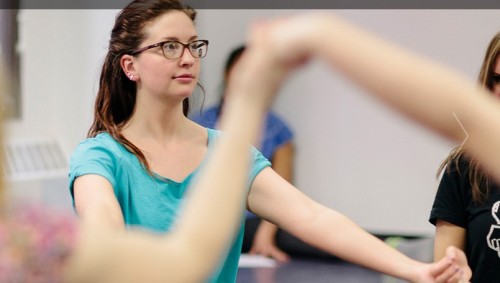
A view from the other side
Now that fall semester of my second year in graduate school is in full swing, I’m starting to realize how quickly time is truly flying by. Thinking back to when I was first applying, I remember reading a former blog about what the typical day of a first year Dance/Movement Therapy & Counseling student looked like, and how illuminating it was for me. Now that I have been given the opportunity to continue the role of graduate ambassador for my program, I would love to shed some light on what the life of a second year Dance/Movement Therapy & Counseling student really looks like.

DMT II photo courtesy of “http://www.colum.edu/academics/fine-and-performing-arts/creative-arts-therapies/graduate-programs.html”
The first important thing to keep in mind when going into year two, is that we not only have class on Tuesdays and Thursdays, but we also now have 24 hours of internship we must complete each week along with our coursework. Many of us go to our internship sites on Mondays, Wednesdays and Fridays, however there are a few of us who also go to their sites on the weekends. It is completely up to you and the specific site you decide to work at!
On Tuesdays, our first class of the day is Clinical Appraisal and Treatment Planning. This course is considered the third sequence in dance/movement therapy and counseling theory, with the prerequisites of Observation and Assessment, Psychopathology, and Theories and Principles of Counseling. It is a multifaceted class, demanding that we now take the knowledge we have acquired about psychological paradigms and dance/movement therapy methodologies, and apply them accordingly to a specific population. This is an integral course at this point in our education because we are directly applying these techniques we are learning to our internship sites. This class usually runs for about 3 hours, and then we are off to our next subject!

DMT courtesy of “http://www.colum.edu/academics/fine-and-performing-arts/creative-arts-therapies/index.html”
Next is Theories & Techniques of Counseling II. This is actually considered the conjunctive course to Theories & Principles of Counseling, providing us with the history and current trends of psychotherapy through the examination of of major theoretical frameworks. This class is a great inroad for us to continue developing our theoretical perspectives and worldviews as future dance/movement therapists. This class also runs for about 3 hours and then we are actually out by 3:20pm (which is quite early for us normally!). The hardest part about Tuesdays is how extremely “heady” and cognitively demanding the courses are. We rarely have the opportunity to move which is difficult as we are extremely kinesthetic learners. However many of us attempt to take any form of class in the evening that demands some type of physical activity. I am personally looking forward to having rehearsals for our upcoming concert on Tuesday nights as an opportunity for me to have a physical and emotional outlet.
Thursdays are a little different because they begin with Thesis Seminar, which is split into 2 groups that meet on alternating weeks. This class is only 2 hours long, but it is often jam-packed with crucial information. Thesis seminar is extremely important because it provides us with the guidance and direction we need as we begin to refine our topics and present our thesis proposals to the Departmental Thesis Committee (DTC) and the Internal Review Board (IRB). It is extremely nerve-wracking but an incredibly important step towards the fulfillment of our degrees.
After thesis seminar, we actually have a few hours to break. This provides us with time to work on our thesis proposals, finish readings and homework, or even meet with our thesis advisers. We then get the opportunity to have Clinical Supervision with our academic supervisors for another two hours. Clinical Supervision provides us with the support and professional guidance that we need while we continue to work at our internship sites throughout the year. This is the best way to end the week, providing us with the opportunity to clear the air, reflect, and process what has been happening for us within our clinical sites. This guidance also further provides us with the tools that we will need for the professional field in the future.
So that about sums it up! We try our best to manage our busy schedules, and attempt to make time for a social life, or possibly even work, but at the end of the day—this is truly the time where the most influential learning is taking place!


